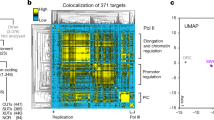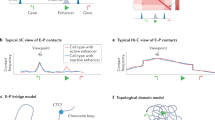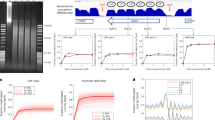Abstract
We present the first complete high-resolution map of nucleosome occupancy across the whole Saccharomyces cerevisiae genome, identifying over 70,000 positioned nucleosomes occupying 81% of the genome. On a genome-wide scale, the persistent nucleosome-depleted region identified previously in a subset of genes demarcates the transcription start site. Both nucleosome occupancy signatures and overall occupancy correlate with transcript abundance and transcription rate. In addition, functionally related genes can be clustered on the basis of the nucleosome occupancy patterns observed at their promoters. A quantitative model of nucleosome occupancy indicates that DNA structural features may account for much of the global nucleosome occupancy.
This is a preview of subscription content, access via your institution
Access options
Subscribe to this journal
Receive 12 print issues and online access
$209.00 per year
only $17.42 per issue
Buy this article
- Purchase on SpringerLink
- Instant access to full article PDF
Prices may be subject to local taxes which are calculated during checkout






Similar content being viewed by others
Accession codes
References
Noll, M. & Kornberg, R.D. Action of micrococcal nuclease on chromatin and the location of histone H1. J. Mol. Biol. 109, 393–404 (1977).
Richmond, T.J. & Davey, C.A. The structure of DNA in the nucleosome core. Nature 423, 145–150 (2003).
Jenuwein, T. & Allis, C.D. Translating the histone code. Science 293, 1074–1080 (2001).
Lohr, D. & Lopez, J. GAL4/GAL80-dependent nucleosome disruption/deposition on the upstream regions of the yeast GAL1–10 and GAL80 genes. J. Biol. Chem. 270, 27671–27678 (1995).
Martinez-Campa, C. et al. Precise nucleosome positioning and the TATA box dictate requirements for the histone H4 tail and the bromodomain factor Bdf1. Mol. Cell 15, 69–81 (2004).
Straka, C. & Horz, W. A functional role for nucleosomes in the repression of a yeast promoter. EMBO J. 10, 361–368 (1991).
Bernstein, B.E., Liu, C.L., Humphrey, E.L., Perlstein, E.O. & Schreiber, S.L. Global nucleosome occupancy in yeast. Genome Biol. 5, R62 (2004).
Yuan, G.C. et al. Genome-scale identification of nucleosome positions in S. cerevisiae . Science 309, 626–630 (2005).
Lee, C.K., Shibata, Y., Rao, B., Strahl, B.D. & Lieb, J.D. Evidence for nucleosome depletion at active regulatory regions genome-wide. Nat. Genet. 36, 900–905 (2004).
Ioshikhes, I.P., Albert, I., Zanton, S.J. & Pugh, B.F. Nucleosome positions predicted through comparative genomics. Nat. Genet. 38, 1210–1215 (2006).
Segal, E. et al. A genomic code for nucleosome positioning. Nature 442, 772–778 (2006).
David, L. et al. A high-resolution map of transcription in the yeast genome. Proc. Natl. Acad. Sci. USA 103, 5320–5325 (2006).
MacIsaac, K.D. et al. An improved map of conserved regulatory sites for Saccharomyces cerevisiae . BMC Bioinformatics 7, 113 (2006).
Harbison, C.T. et al. Transcriptional regulatory code of a eukaryotic genome. Nature 431, 99–104 (2004).
Moreira, J.M. & Holmberg, S. Nucleosome structure of the yeast CHA1 promoter: analysis of activation-dependent chromatin remodeling of an RNA-polymerase-II-transcribed gene in TBP and RNA pol II mutants defective in vivo in response to acidic activators. EMBO J. 17, 6028–6038 (1998).
Sekinger, E.A., Moqtaderi, Z. & Struhl, K. Intrinsic histone-DNA interactions and low nucleosome density are important for preferential accessibility of promoter regions in yeast. Mol. Cell 18, 735–748 (2005).
Liu, X., Lee, C.K., Granek, J.A., Clarke, N.D. & Lieb, J.D. Whole-genome comparison of Leu3 binding in vitro and in vivo reveals the importance of nucleosome occupancy in target site selection. Genome. Res. 16, 1517–1528 (2006).
Holstege, F.C. et al. Dissecting the regulatory circuitry of a eukaryotic genome. Cell 95, 717–728 (1998).
Carrozza, M.J. et al. Histone H3 methylation by Set2 directs deacetylation of coding regions by Rpd3S to suppress spurious intragenic transcription. Cell 123, 581–592 (2005).
Keogh, M.C. et al. Cotranscriptional set2 methylation of histone H3 lysine 36 recruits a repressive Rpd3 complex. Cell 123, 593–605 (2005).
Raisner, R.M. et al. Histone variant H2A.Z marks the 5′ ends of both active and inactive genes in euchromatin. Cell 123, 233–248 (2005).
Ashburner, M. et al. Gene ontology: tool for the unification of biology. The Gene Ontology Consortium. Nat. Genet. 25, 25–29 (2000).
Satchwell, S.C., Drew, H.R. & Travers, A.A. Sequence periodicities in chicken nucleosome core DNA. J. Mol. Biol. 191, 659–675 (1986).
Wang, Y.H., Amirhaeri, S., Kang, S., Wells, R.D. & Griffith, J.D. Preferential nucleosome assembly at DNA triplet repeats from the myotonic dystrophy gene. Science 265, 669–671 (1994).
Suter, B., Schnappauf, G. & Thoma, F. Poly(dA.dT) sequences exist as rigid DNA structures in nucleosome-free yeast promoters in vivo . Nucleic Acids Res. 28, 4083–4089 (2000).
Wong, B., Chen, S., Kwon, J.A. & Rich, A. Characterization of Z-DNA as a nucleosome-boundary element in yeast Saccharomyces cerevisiae . Proc. Natl. Acad. Sci. USA 104, 2229–2234 (2007).
Morse, R.H. Getting into chromatin: how do transcription factors get past the histones? Biochem. Cell Biol. 81, 101–112 (2003).
Roth, F.P., Hughes, J.D., Estep, P.W. & Church, G.M. Finding DNA regulatory motifs within unaligned noncoding sequences clustered by whole-genome mRNA quantitation. Nat. Biotechnol. 16, 939–945 (1998).
Lascaris, R.F., Groot, E., Hoen, P.B., Mager, W.H. & Planta, R.J. Different roles for abf1p and a T-rich promoter element in nucleosome organization of the yeast RPS28A gene. Nucleic Acids Res. 28, 1390–1396 (2000).
Fedor, M.J., Lue, N.F. & Kornberg, R.D. Statistical positioning of nucleosomes by specific protein-binding to an upstream activating sequence in yeast. J. Mol. Biol. 204, 109–127 (1988).
Yarragudi, A., Miyake, T., Li, R. & Morse, R.H. Comparison of ABF1 and RAP1 in chromatin opening and transactivator potentiation in the budding yeast Saccharomyces cerevisiae . Mol. Cell. Biol. 24, 9152–9164 (2004).
Huh, W.K. et al. Global analysis of protein localization in budding yeast. Nature 425, 686–691 (2003).
Liu, C.L. et al. Single-nucleosome mapping of histone modifications in S. cerevisiae . PLoS Biol. 3, e328 (2005).
Kornberg, R.D. & Stryer, L. Statistical distributions of nucleosomes: nonrandom locations by a stochastic mechanism. Nucleic Acids Res. 16, 6677–6690 (1988).
Tibshirani, R. Regression shrinkage and selection via the Lasso. J. R. Stat. Soc. Ser. B Methodol. 58, 267–288 (1996).
el Hassan, M.A. & Calladine, C.R. Propeller-twisting of base-pairs and the conformational mobility of dinucleotide steps in DNA. J. Mol. Biol. 259, 95–103 (1996).
Kasten, M.M. & Stillman, D.J. Identification of the Saccharomyces cerevisiae genes STB1–STB5 encoding Sin3p binding proteins. Mol. Gen. Genet. 256, 376–386 (1997).
Hogan, G.J., Lee, C.K. & Lieb, J.D. Cell cycle-specified fluctuation of nucleosome occupancy at gene promoters. PLoS Genet. 2, e158 (2006).
Albert, I. et al. Translational and rotational settings of H2A.Z nucleosomes across the Saccharomyces cerevisiae genome. Nature 446, 572–576 (2007).
Johnson, S.M., Tan, F.J., McCullough, H.L., Riordan, D.P. & Fire, A.Z. Flexibility and constraint in the nucleosome core landscape of Caenorhabditis elegans chromatin. Genome Res. 16, 1505–1516 (2006).
Studitsky, V.M., Kassavetis, G.A., Geiduschek, E.P. & Felsenfeld, G. Mechanism of transcription through the nucleosome by eukaryotic RNA polymerase. Science 278, 1960–1963 (1997).
Ozsolak, F., Song, J.S., Liu, X.S. & Fisher, D.E. High-throughput mapping of the chromatin structure of human promoters. Nat. Biotechnol. 25, 244–248 (2007).
Zanton, S.J. & Pugh, B.F. Full and partial genome-wide assembly and disassembly of the yeast transcription machinery in response to heat shock. Genes Dev. 20, 2250–2265 (2006).
Kampa, D. et al. Novel RNAs identified from an in-depth analysis of the transcriptome of human chromosomes 21 and 22. Genome Res. 14, 331–342 (2004).
Macisaac, K.D. et al. A hypothesis-based approach for identifying the binding specificity of regulatory proteins from chromatin immunoprecipitation data. Bioinformatics 22, 423–429 (2006).
Ponomarenko, J.V. et al. Conformational and physicochemical DNA features specific for transcription factor binding sites. Bioinformatics 15, 654–668 (1999).
Sivolob, A., De Lucia, F., Alilat, M. & Prunell, A. Nucleosome dynamics. VI. Histone tail regulation of tetrasome chiral transition. A relaxation study of tetrasomes on DNA minicircles. J. Mol. Biol. 295, 55–69 (2000).
Champ, P.C., Maurice, S., Vargason, J.M., Camp, T. & Ho, P.S. Distributions of Z-DNA and nuclear factor I in human chromosome 22: a model for coupled transcriptional regulation. Nucleic Acids Res. 32, 6501–6510 (2004).
Efron, B., Hastie, T., Johnstone, I. & Tibshirani, R. Least angle regression. Ann. Stat. 32, 407–451 (2004).
Acknowledgements
We thank G. Giaever for scientific advice; members of the HIP-HOP labs at Stanford and Toronto for advice and encouragement; C. Palm for help with data analysis; S.J. Altschuler (Univ. Texas Southwester Medical Center) and G.-C. Yuan (Harvard Univ.) for software for the HMM; and Z. Zhang, Q. Morris and E. Chan for discussions. W.L. is supported by a training grant from the US National Institutes of Health, and the work was supported by grants from the National Human Genome Research Institute (R.W.D. and C.N.), the National Science Foundation (R.H.M.), Genome Canada and the Ontario Genomics Institute (N.B., D.T. and T.R.H.).
Author information
Authors and Affiliations
Contributions
W.L. preformed experiments, collected and analyzed the data, prepared figures and co-wrote the paper. R.W.D. provided essential input into the study design and interpretation. D.T. designed the Lasso model, analyzed all of the data, ran the HMM, and prepared figures. N.B. did data analysis on TFBSs. R.H.M. contributed to the initial study design, provided essential experimental advice, and contributed text. T.R.H. directed the detailed data analysis, and contributed figures and text. C.N. designed the study, directed the work and wrote the paper.
Corresponding author
Supplementary information
Supplementary Text and Figures
Supplementary Figure 1–3 (PDF 1700 kb)
Rights and permissions
About this article
Cite this article
Lee, W., Tillo, D., Bray, N. et al. A high-resolution atlas of nucleosome occupancy in yeast. Nat Genet 39, 1235–1244 (2007). https://doi.org/10.1038/ng2117
Received:
Accepted:
Published:
Issue Date:
DOI: https://doi.org/10.1038/ng2117
This article is cited by
-
Quantitative analysis of transcription start site selection reveals control by DNA sequence, RNA polymerase II activity and NTP levels
Nature Structural & Molecular Biology (2024)
-
Histone H2A monoubiquitination marks are targeted to specific sites by cohesin subunits in Arabidopsis
Nature Communications (2023)
-
New insights into genome annotation in Podospora anserina through re-exploiting multiple RNA-seq data
BMC Genomics (2022)
-
Alternative transcription start sites contribute to acute-stress-induced transcriptome response in human skeletal muscle
Human Genomics (2022)
-
Chemically Induced Chromosomal Interaction (CICI) method to study chromosome dynamics and its biological roles
Nature Communications (2022)




